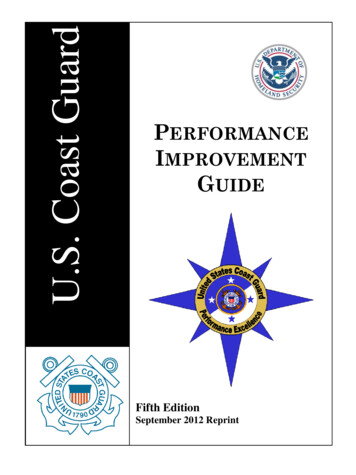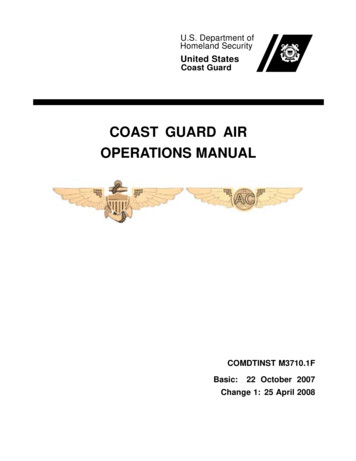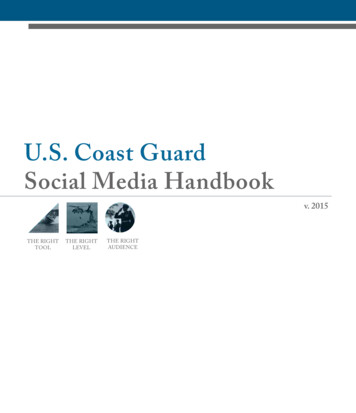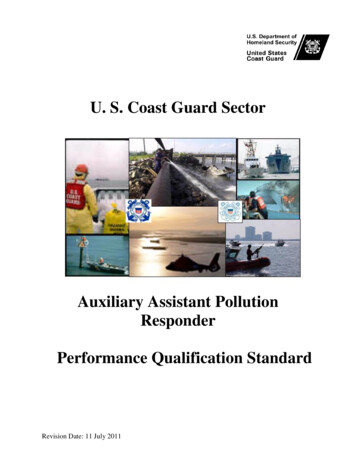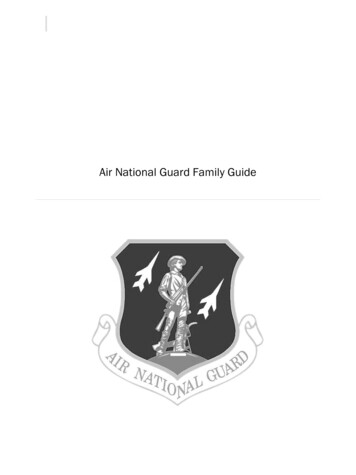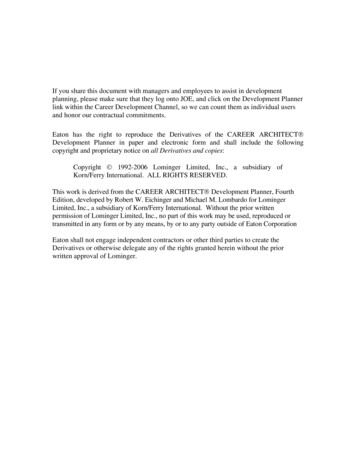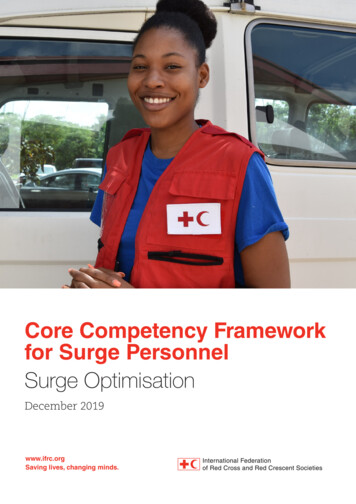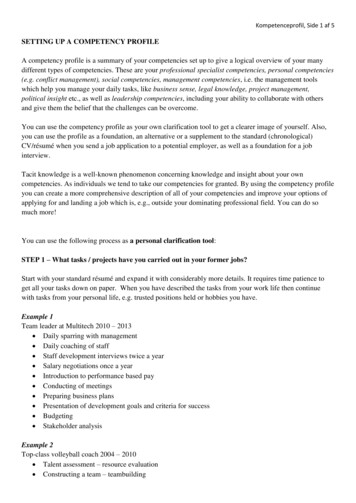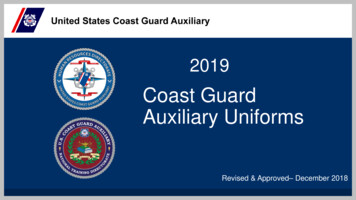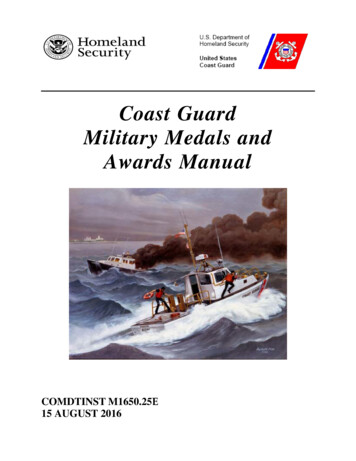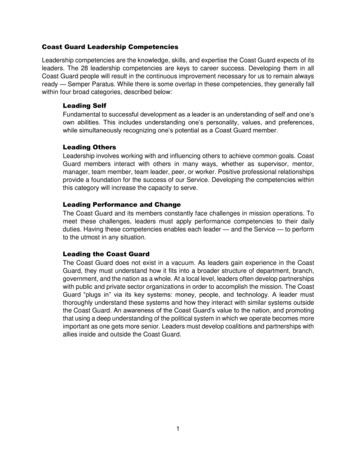
Transcription
Coast Guard Leadership CompetenciesLeadership competencies are the knowledge, skills, and expertise the Coast Guard expects of itsleaders. The 28 leadership competencies are keys to career success. Developing them in allCoast Guard people will result in the continuous improvement necessary for us to remain alwaysready — Semper Paratus. While there is some overlap in these competencies, they generally fallwithin four broad categories, described below:Leading SelfFundamental to successful development as a leader is an understanding of self and one’sown abilities. This includes understanding one’s personality, values, and preferences,while simultaneously recognizing one’s potential as a Coast Guard member.Leading OthersLeadership involves working with and influencing others to achieve common goals. CoastGuard members interact with others in many ways, whether as supervisor, mentor,manager, team member, team leader, peer, or worker. Positive professional relationshipsprovide a foundation for the success of our Service. Developing the competencies withinthis category will increase the capacity to serve.Leading Performance and ChangeThe Coast Guard and its members constantly face challenges in mission operations. Tomeet these challenges, leaders must apply performance competencies to their dailyduties. Having these competencies enables each leader — and the Service — to performto the utmost in any situation.Leading the Coast GuardThe Coast Guard does not exist in a vacuum. As leaders gain experience in the CoastGuard, they must understand how it fits into a broader structure of department, branch,government, and the nation as a whole. At a local level, leaders often develop partnershipswith public and private sector organizations in order to accomplish the mission. The CoastGuard “plugs in” via its key systems: money, people, and technology. A leader mustthoroughly understand these systems and how they interact with similar systems outsidethe Coast Guard. An awareness of the Coast Guard’s value to the nation, and promotingthat using a deep understanding of the political system in which we operate becomes moreimportant as one gets more senior. Leaders must develop coalitions and partnerships withallies inside and outside the Coast Guard.1
28 Leadership CompetenciesCategory: Leading SelfAccountability and ResponsibilityCoast Guard leaders know ours is a military service and recognize the organizational structureand the chain of command. Each individual is sensitive to the impact of his or her behavior onothers and the organization. Leaders take ownership for their areas of responsibility, areaccountable to effectively organize and prioritize tasks, and efficiently use resources. Regulationsand guidelines that govern accountability and responsibility allow leaders to use appropriateformal tools to hold others accountable when situations warrant.FollowershipAll Coast Guard members are followers. The followership role encompasses initiative,commitment, responsibility, accountability, critical thinking, and effective communications.Followers look to leaders for guidance and feedback; they expect challenging tasks to both learnand develop competence. Actively involved, they seek to understand through listening,responsible questioning and feedback. Followers have the responsibility to work with leaders toensure successful mission accomplishment.Self-Awareness and LearningCoast Guard leaders continually develop their knowledge, skills, and expertise as the cornerstonefor building their emotional intelligence which will maximize their effectiveness. They should beaware of their own unconscious biases and learn how to manage their conscious biases. Theyunderstand that their natural state, without these interventions, tens to lean toward self-cloningand self-interest, and that mission readiness is enhanced with diverse perspectives. Coast Guardleaders understand that inclusive leadership and professional development is a life-long journeywith many phases. The continuum ranges from being unaware to being an advocate for othersand change. Inclusive leaders value curiosity and a growth mindset and seek feedback fromothers. They practice self-reflection to learn from experience, as well as the experiences of others,to develop more complex ways of thinking.Aligning ValuesCoast Guard leaders develop and maintain an understanding of the Coast Guard Core Values ofHonor, Respect and Devotion to Duty. Leaders align personal values with organizational values,reconciling any differences that exist. Leaders embody the highest standards of Coast GuardCore Values, can communicate their meaning, hold peers and subordinates accountable to theseorganizational merits, and use them to guide performance, conduct, and decisions—every day.Health and Well-BeingLeaders consider the environment in which they and their people work, attending to safety andwell-being. They effectively identify and manage stress. They set a personal health example withemphasis on a program of physical fitness and emotional strength. Leaders encourage others todevelop personal programs including physical, mental, and spiritual well-being.2
Personal ConductLeaders demonstrate belief in their own abilities and ideas; are self-motivated, results-oriented,and accountable for their performance; recognize personal strengths and weaknesses;emphasize personal character development; and use position and personal power appropriately.They understand the relevance and importance of Coast Guard Core Values and strive forpersonal conduct that exemplifies these values.Technical ProficiencyCoast Guard leaders’ technical knowledge, skills, and expertise allow them to effectively organizeand prioritize tasks and use resources efficiently. Always aware of how their actions contribute tooverall organizational success, leaders demonstrate technical and functional proficiency. Theymaintain credibility with others on technical matters and keep current on technological advancesin professional areas. Successful leaders work to initiate actions and competently maintainsystems in their area of responsibility.Category: Leading OthersEffective CommunicationsCoast Guard leaders communicate effectively in both formal and informal settings. Good listeners,they reinforce the message they convey with supportive mannerisms. Leaders express facts andideas succinctly and logically, facilitate an open exchange of ideas, ask for feedback routinely,and communicate face-to-face whenever possible. They write clear, concise, and organizedcorrespondence and reports. Successful leaders prepare and deliver effective presentations. Insituations requiring public speaking they deliver organized statements, field audience questions,confidently communicate with the media and other external entities, and distinguish betweenpersonal communication situations and those as a Coast Guard representative. Competentcoaches, supervisors, followers, performance counselors, interviewers, and negotiators, leadersknow how to approach many situations to achieve organizational goals.Influencing OthersCoast Guard leaders possess the ability to persuade and motivate others to achieve the desiredoutcome: to create change. They influence and persuade by communicating, directing, coaching,and delegating, as the situation requires. Successful leaders understand the importance andrelevance of professional relationships, develop networks, gain cooperation and commitmentfrom others, build consensus, empower others by sharing power and responsibility, and establishand maintain rapport with key players.Cultural FluencyCoast Guard leaders develop cultural fluency as stewards of our entire workforce. Culturally fluentleaders recognize, respect, and demonstrate that there can be different ways of knowing,learning, communicating, and achieving goals through leveraging our diverse workforce. Theydemonstrate emotional intelligence and social awareness by managing relationships with anunderstanding of how racism, privilege, social construct, identity, differing abilities, and bias canimpact our workforce. They are aware of their power and take the time to reflect about how others3
may interpret their actions. They build psychological safety with their teams to increaseunderstanding. They are able to respectfully navigate cultural differences and conflicts, tensions,or misunderstandings. Culturally fluent leaders actively guide and influence others toward equityfor marginalized persons to build an inclusive workforce.Team BuildingLeaders recognize and contribute to group processes; encourage and facilitate cooperation,pride, trust, and group identity; and build commitment, team spirit, and strong relationships. CoastGuard leaders inspire, guide, and create an environment that motivates others toward goalaccomplishment; consider and respond to others’ needs, feelings, and capabilities; and adjusttheir approach to suit various individuals and situations. Coast Guard leaders have a historicalperspective of leadership theory that they continually develop through personal experience andstudy of contemporary leadership issues. They work with subordinates to develop their leadershipknowledge and skills. Coast Guard leaders adapt leadership styles to a variety of situations andpersonify high standards of honesty, integrity, trust, openness, and respect for others by applyingthese values and styles to daily behavior.Taking Care of PeopleSuccessful leaders identify others’ needs and abilities in the Coast Guard, particularlysubordinates’. They ensure fair, equitable treatment; project high expectations for subordinatesand/or their teams; express confidence in abilities; recognize efforts; and use reward systemseffectively and fairly. Leaders appropriately support and assist in professional and personalsituations and use formal programs to resolve situations positively.MentoringDrawing on their experience and knowledge, leaders deliberately assist others in developingthemselves, provide objective feedback about leadership and career development, and helpidentify professional potential, strengths, and areas for improvement. Successful leaders identifywith the role of mentor to their staff. They have the skill to advise and develop others in thecompetencies needed to accomplish current and future goals. Leaders seek out mentors forthemselves and may be engaged in the formal Coast Guard mentoring program both as mentorsand mentees.Category: Leading Performance and ChangeCustomer FocusCoast Guard leaders know who their customers are and make every possible effort to find outtheir customers’ needs and to hear their customers’ voices. Leaders understand the importanceof measuring and monitoring the degree to which their customers’ needs are met or exceededand continually strive to improve that. Coast Guard leaders understand the distinction between“customer” and “boss” and act accordingly to balance competing demands.Management and Process ImprovementSuccessful leaders demonstrate the ability to plan, organize, and prioritize realistic tasks andresponsibilities for themselves and their people. They use goals, milestones, and control4
mechanisms for projects. Leaders seek, anticipate, and meet customers’ needs—internal andexternal. To achieve quality results, Coast Guard leaders monitor and evaluate progress andoutcomes produced by current processes, ensure continuous improvement through periodicassessment, and are committed to improving products, services, and overall customersatisfaction. They effectively manage time and resources to successfully accomplish goals.Decision Making and Problem SolvingLeaders identify and analyze problems; use facts, input from others, and sound reasoning toreach conclusions; explore various alternative solutions; distinguish between relevant andirrelevant information; perceive the impact and implications of decisions; and commit to action,even in uncertain situations, to accomplish organizational goals. They evaluate risk levels, createrisk control alternatives, and implement risk controls. Successful leaders are able to isolate highimportance issues, analyze pertinent information, involve others in decisions that affect them,generate promising solutions, and consistently render judgments with lasting, positive impact.Conflict ManagementCoast Guard leaders facilitate open communication of controversial issues while maintainingrelationships and teamwork. They effectively use collaboration as a style of managing contention;confront conflict positively and constructively to minimize impact to self, others, and theorganization; and reduce conflict and build relationships and teams by specifying clear goals,roles, and processes.Inclusive CollaborationCoast Guard leaders encourage collaboration, creative thinking, and innovative solutions toovercome/tackle the volatile, uncertain, complex and ambiguous challenges of the workenvironment. They create awareness and support by engaging multiple perspectives for keydecisions and maintain collaboration throughout the change management process. They takemeasured risks, learn from the challenges, and encourage others to do the same. They apply thissame process to those who work for them. They build psychological safety by empoweringindividuals to be authentic and to feel comfortable sharing their perspectives. They construct anenvironment where people believe their contributions are valued.Vision Development and ImplementationLeaders are able to envision a preferred future for their units and functions, setting this picture inthe context of the Coast Guard’s overall vision, missions, strategy, and driving forces. Concernedwith long-term success, leaders establish and communicate organizational objectives and monitorprogress toward objectives; initiate action; and provide structure and systems to achieve goals.Leaders create a shared vision of the organization, promote wide ownership, manage andchampion organizational change, and engineer changes in processes and structure to improveorganizational goal accomplishment.Category: Leading the Coast GuardStewardshipThe Coast Guard’s unofficial motto was once, “You have to go out – but you don’t have to comeback!” This bravado was a testament to the bravery and commitment to service of Coast Guard5
men and women. But a more appropriate motto might be, “You have to go out, and you have tocome back, and you have to bring our resources back because we’ll need them again tomorrow!”Performing the mission at ANY cost is an unacceptable risk, not only to those immediatelyinvolved, but to all those who would have benefited from the efforts of those people and theirresources tomorrow, and next week, and next year. Protecting the nation’s investment isimportant and presents a difficult decision when it means failing now in order to succeedtomorrow. Achieving the proper balance is a crucial element of leading.Technology ManagementTechnological advances make it possible to improve mission performance, provided prudentinvestments are made up front. Coast Guard leaders use efficient and cost-effective approachesto integrate technology into the workplace and improve program effectiveness. Leaders developstrategies using new technology to enhance decision-making. They fully appreciate the impact oftechnological changes on the organization.Financial ManagementThe Coast Guard’s budget and financial management systems are analogous to a nervoussystem. Leaders must demonstrate broad understanding of the principles of financialmanagement and marketing expertise necessary to ensure appropriate funding levels for theirareas of responsibility. They prepare, justify, and/or administer the budget for the unit or program;use cost-benefit thinking to set priorities; and monitor expenditures in support of programs andpolicies. Leaders seek and identify cost-effective approaches and manage procurement andcontracting appropriately.Talent Acquisition & Employee DevelopmentCoast Guard leaders leverage their knowledge of team member’s qualities and accomplishmentsto advocate for equity in tasks, assignments, evaluations, formal training, mentoring programs,and advancement, and provide timely feedback when needed. They demonstrate an inclusivetalent mindset by recognizing when institutional biases limit access and full participation and takeaction to promote diverse team composition. Leaders develop and implement strategies to attractand retain a diverse workforce to maximize staffing needs and better realize organizational goals.They identify and address race, gender, or other discriminating inequities that may occurthroughout all organizational levels. Coast Guard leaders develop and maintain human resourcesystems and policies that are adaptable to the evolving workforce needs and promote a cultureof belonging where individuals thrive personally and professionally.PartneringThe Coast Guard exists within a broader envelope of partners and stakeholder organizations.Leaders must develop networks and build alliances, engaging in cross-functional activities whereit makes sense. Leaders collaborate across boundaries and find common ground with a wideningrange of stakeholders at the local and national level and use their contacts to build and strengtheninternal bases of support.External AwarenessLeaders identify and keep up to date on key national and international policies and economic,political, and social trends that affect the organization. Coast Guard leaders understand near-term6
and long-range plans and determine how best to be positioned to achieve the advantage in anincreasingly competitive national economic climate.EntrepreneurshipLeaders seek and identify opportunities to develop and market new products and services withinor outside of the Coast Guard. Leaders are willing to take risks and initiate actions that involve adeliberate risk to achieve a recognized benefit or advantage.Political SavvyCoast Guard leaders identify the internal and external politics that impact the work of the CoastGuard and the Department. Leaders approach each problem situation with a clear perception oforganizational and political reality and recognize the impact of alternative courses of action.Strategic ThinkingCoast Guard leaders react to crises immediately and routinely solve urgent problems. In keepingwith the concepts described as Stewardship, Coast Guard leaders must also consider multipletime horizons and very complex interactions. This requires thinking strategically, which consistsof adopting a systems view, focusing on intent—what are we really trying to accomplish?, thinkingacross time horizons, creating and testing hypotheses, and being intelligently opportunistic—taking advantage of current conditions.7
Coast Guard Leadership Competencies Leadership competencies are the knowledge, skills, and expertise the Coast Guard expects of its leaders. The 28 leadership competencies are keys to career success. Developing them in all Coast Guard people will result in the continuous improvement necessary for us to remain always ready — Semper Paratus.
